Tag: Protecting animal populations
The centre works tirelessly to breed critically endangered birds to be reintroduced back into the wild at safe habitat sites.
Matt took some time out of his busy schedule to answer some questions for us.

How did you come to be at the CCBC?
“After my internship at Chester Zoo I was offered the chance to stay at the zoo as a bird keeper on a short contract. The contract was coming to a close and Andrew Owen, curator of birds, offered me the chance to come to Indonesia to work at CCBC. Obviously the chance to gain more experience working with critically endangered birds in Indonesia was an opportunity too good to turn down.
Could you give us with an insight into what a typical day for you is like at CCBC?
“The day usually starts at 7am, unless there are young chicks then 6.30am – the young chicks need to have food available as early as possible. From 7am the birds that I am taking care of that day are fed and given fresh water to drink and have their water baths cleaned and refilled.
“Then I usually prepare crickets and the prey food for the Javan green magpies. We have been breeding crickets as a food source for the birds, so I will also feed these too. If there is time left in the morning then we will do any jobs that need to be done such as cage maintenance, collecting nesting material, building nests, etc.
“The afternoon starts with feeding the Javan green magpies with a mouse or a lizard with the rest of the afternoon usually being for big jobs where the other bird keepers, Ajle and Asep, and I are needed.
What have been your highlights so far?
“Working with the Javan green magpie has been a big highlight for me as they are my favourites here at the centre. I have been doing a small project on how they get the green colour in their feathers and so I have been learning a lot about them.

Javan green magpie. Credit: Matt Speed
What challenges have you had to face whilst being there?
“I have definitely become better at fixing things! At Chester if there is a big job we would usually hand it over to the maintenance department. Here however we do all of the maintenance ourselves. Working with people who don’t speak English can be challenging at times; trying to make ourselves understood to one another can sometimes be hard so I’ve had to learn some Indonesian words that help. We are beginning to focus on getting the Rufous-fronted laughingthrushes, another endangered species, to breed so that will be the biggest challenge from now until I leave.
How has Chester Zoo’s involvement helped the project?
“The financial support helps to feed the birds and has also meant that a fence could be built around the centre to protect the birds from being stolen. Constant contact with Andrew and Javier (veterinary manager at Chester Zoo) has meant that we receive advice and support if, for instance, we have a sick bird about what the best course of action is to take.

Matt receiving husbandry advice and demonstrations from Javier
Other than breeding and reintroduction, are there any other activities happening to conserve these birds?
“There are projects that exist to raise awareness and educate local people about the decline of songbirds. At the release site where Cikananga releases the black winged starling, there is a field team who, apart from monitoring the birds after they are released, talk to local people and schools. They help the local people to understand the importance of protecting the local songbirds and why catching the birds and keeping them in small cages is bad for the birds and bad for the species.”
I am Matt Speed and I Act for Wildlife
Our last-but no means least-blog from the Assam expedition team comes from Lorraine Shuker-health and safety advisor at Chester Zoo.
Lorraine tells us more about the impact the Assam Haathi Project is having on the villagers as well as what she took from her experiences:
“Before I went on the Assam expedition my main objective was that I wanted to add value; I didn’t just want to go along and not contribute in any way.
“I know that a few of us had worries before we went over whether what we had prepared was right. I supported the business workshops, with Jamie Christon and Mike Lowe. But as well as the advice we provided around branding and labelling-we also tried to cover basic first aid in the sessions too.

“My job title (health and safety advisor) threw them a bit – our translator had difficulty explaining what health and safety was as it didn’t really exist there. When they saw ‘health’ the participants thought that they’d be able to get medical knowledge from me.
“We did cover the basics in first aid-but I kept getting asked questions-for example ‘my doctors told me I need to do such and such-what do you think?’ and we had to keep explaining we weren’t medical experts. We covered areas like: what to do if someone is choking-how to treat someone if they’re bleeding-what to do if someone is feeling faint or has a high temperature/ fever.
“We were shocked when Nandita told us that usually when someone has a high fever they wrap someone in blankets and layers-whereas in actual fact that’s probably the worst thing you could do for someone who has got heat exhaustion. So even though the information we were giving them-in terms of appropriate first aid action-was limited I’m hoping there’s still some life-saving techniques that we’ve shared.

“It really was an eye opening experience – my friends and family all asked me if I had a great time-but saying I had a great time didn’t feel right as we worked really hard and it was sometimes arduous and draining. However-it was very rewarding and worthwhile.
“On top of the workshops we were also taken out to visit a number of villages and see where the Assam Haathi Project has supported.

“Our first day out in the field we visited a number of villages. The first we visited was surrounded by a 16 kilometre electric fence. The villagers told us that prior to the fence going up-they couldn’t sleep at night as they were so afraid that the elephants would come into the village – which they would do regularly. This resulted in 12 people form the village dying. One villager talked about how his father had been seriously injured and when he was telling us this you could see it in his face-he was very emotional.
“It meant that they couldn’t grow anything-as their vegetable gardens would get raided by the elephants-but we were told that when the fences went up it was transforming. There was one gentleman who said ‘you are like gods to us’ which really touched us all. Of course-he didn’t mean us personally-he told us as ambassadors of Chester Zoo. It made me feel really proud to work here and be part of it.
“The villagers were so overwhelmed that we’d travelled all that way to help them. They were honoured that we cared about their lives so much that we would travel that distance and spend all that time and effort in helping them.

“We were also showed some of the stoves that the villagers have been building – which are made up of clay and animal dung. They build these stoves so there’s an area to light a small fire. This type of stove uses 50% wood than cooking on an open fire-as it keeps the heat in. It’s much more fuel efficient and prevents them having to rely on the forests. Some villagers can’t afford to buy a gas container to cook on therefore they are going into the forest and cutting down trees-which is constantly nibbling away at the habitat.


“By the Assam Haathi Project providing the villagers with a chimney-which is made of metal-the advantage to them is that they can direct smoke away from the rest of their home-and the advantage for elephants is that their habitat is being depleted less.
“As a result of the expedition I would like to share more about the conservation work with our visitors-and more importantly those that don’t come and visit the zoo. I don’t think people are fully aware of all the projects we support around the world. We don’t just look after the animals in the zoo-we’re doing so much around the world-so I would like to try and get that message out there.

“In Assam-they do revere the elephant. It is a really important animal in India – Ganesh-one of their gods-has the head of an elephant – and the fact that they’re in conflict with it is really distressing for them. So if you put yourself in their shoes-as much as you may love elephants-if they’re coming knocking down your house on a regular basis you eventually begin to resent their presence. We met one lady who had had her home knocked down six times in one year!

“I think the Assam Haathi Project is so important – it’s enabling people to continue having a relationship with elephants-which they must have had for thousands of years.
“Seeing the everyday work the project is doing was a real eye opener – seeing them building the relationships with the different villages-building the stoves-maintaining the electric fences-etc. It’s an accumulation of lots of different things that makes the project so successful.
“The project is actually people – it’s an accumulative effect of lots of people’s passion and effort.
“The people can sleep at night rather than live in fear. It’s all the basics – safety and security for their families. We see elephants as this magnificent creature but imagine if one was coming into your back garden-knocking down your house and stealing the food that you needed to feed your children with the next day – you would be terrified of it and could eventually become to hate them. It’s a big dangerous creature!
“It’s about people being able to live alongside them and not be afraid of them-as ultimately if they’re afraid of them they could hurt them. So if you want to help protect the elephants you have to help the people to protect themselves so they can leave the elephants alone.”

“This expedition has made me even more proud of the organisation I work for and it’s made me admire the people who work on our conservation projects-and it makes me thankful to all our visitors who come here and help us to continue the work we’re doing out in the field.”
Peter’s main role was to offer practical advice and maintenance for the solar powered electric fences that are used to protect the crops from elephants.
Here he provides us with more information about his experiences and what he found when working in India:
“Before I left for Assam I had a good idea of what activities I’d be getting up to while I was there. I was really looking forward to getting stuck in and helping where possible! It was my job to provide the villagers with any assistance and offer my advice on how to maintain the electric fences and spotlights that are used to protect the villagers-crops and homes from elephant encroachment.
“Prior to the expedition I prepared a presentation on basic electrical theory with the aim that this would help improve skills and further the villagers’ knowledge. I also packed a selection of tools to take with me-including electric fence testers-multi-meters and general hand-tools. I made sure I was well equipped.
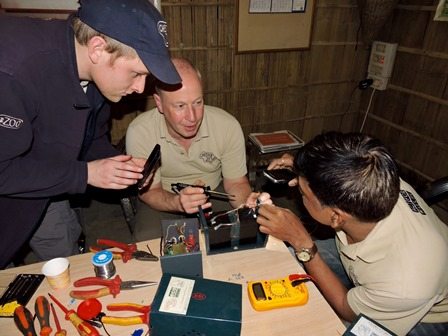
“The change in climate wasn’t a big shock to me – as I’d been lucky enough to travel to this part of the world before-so I had an idea of what to expect. The cities were really busy and hectic but in the remote areas life was more relaxed. I also felt the climate was comfortable and not too humid-it was the winter season – although saying that-it’s nothing like the winters we have here in the UK! Temperatures were still reaching around 30 degrees.
“The workshop I put together included a presentation providing a basic electrical course and an electrical fencing guide-which was then followed by a practical session. I think those who attended the workshop enjoyed it and I did get asked quite a few times about how to test the output voltage on an electric fence – so it was a good job I packed my electric fence testers!
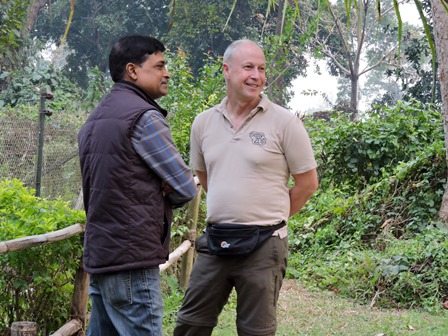
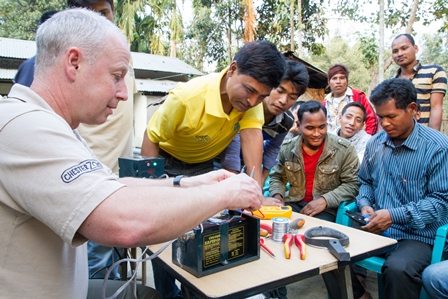
“On top of that we carried out repairs on the electric fences-spotlights-chargers and torches in each of the villages. We also spent some time checking the batteries – inspecting their levels-cleaning the terminals and looking over the general condition of the electric fence line. Just by doing these simple checks meant that the fences could continue to give 100% output-keeping the elephants away from the crops and out of the villages.
“It was really satisfying to know that I was helping others simply by sharing my skills. The people I spoke to were extremely keen to learn more about the electric fence testing and general electrical maintenance skills. The problems and issues which the villages came to me about were mainly to do with the different electrical equipment they had that wasn’t working.
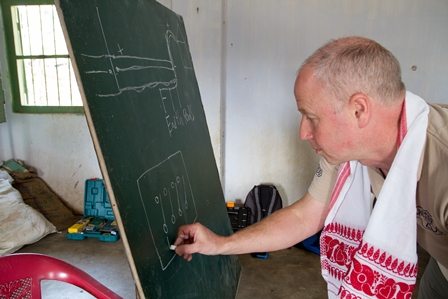
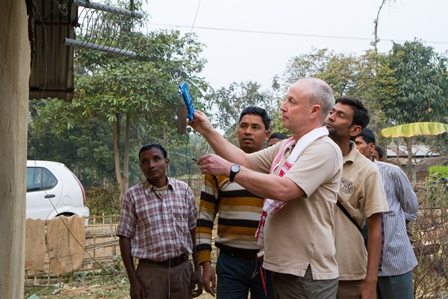
“Seeing the work Chester Zoo’s Assam Haathi Project does first-hand makes me realise-even more-just how important it is. This project is not only protecting elephants but it is helping to give people a better quality of life.
“A full day of visiting various villages-running presentations and repairing different faults on electrical equipment was really fulfilling. It was nice to meet up with the rest of the group after a hard day’s work and reflect on our experiences – we were often treated to a cultural dance from the locals-and on some occasions a rice beer!
“It was really rewarding to see how this project is helping to improve the quality of life for the villagers-and also knowing that this has a huge impact on the welfare of elephants.
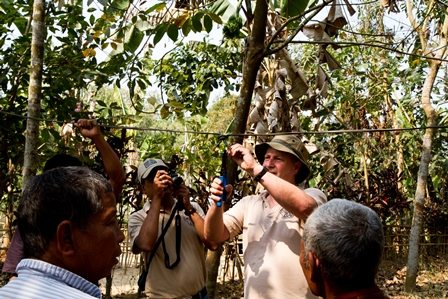
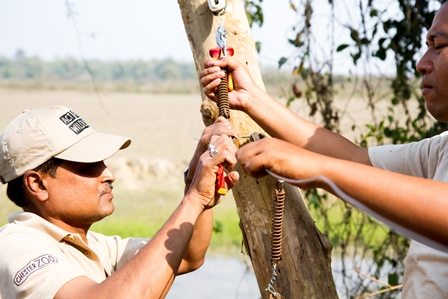
“The expedition was everything I expected it to be and seemed to be a great success. I really hope some of our knowledge and skills have been passed on.”
The Assam Haathi expedition seems like a long time ago now-but we still have plenty to share with you!
The Chester Zoo team were led by the zoo’s managing director-Jamie Christon. Jamie offered help and advice to the women’s self-help groups who have set up and run small businesses in Assam. These businesses produce and sell items such as woven garments and bamboo crafts-to increase the income to their village.
Along with Lorraine Shuker (health and safety advisor) and Mike Lowe (security officer) the three members of staff formed the ‘business group’-and the workshop they presented aimed to help villagers improve their business skills.
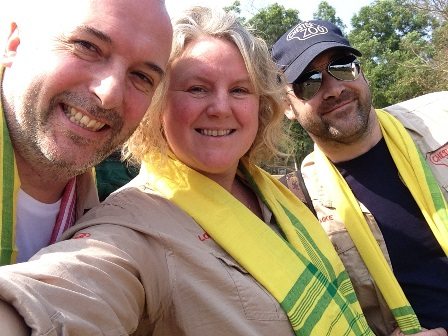
Here Jamie tells us more:
“India was a brand new experience for me-as was having the opportunity to travel on a zoo expedition. This expedition was a bit unusual and the first time Chester Zoo had looked at trying to develop business skills as well as the other workshop topics in the field.
“Assamese life was a whole world away from life in the UK and Chester. Both in the noisy-dust filled streets of Guwahati out to the more tranquil lanes of the beautiful countryside-our eyes and ears were constantly looking at and hearing new experiences and sights. Each morning you were woken by a car horn-a call to prayer-a cockerel-or another bird in and around our camps and hotels.
“Each day we set off on another adventure in to the Assam countryside – travelling-on some days-great distances to meet villagers.
“We were welcomed by each and every villager and were well taken care of by the field assistants on hand from the Assam Haathi Project team.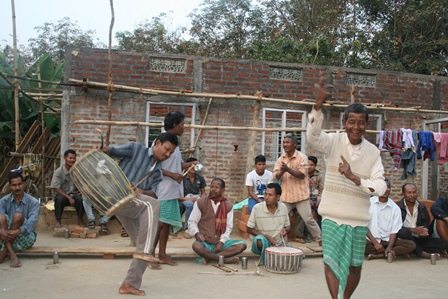
“We held four workshop sessions over four days-two in Goalpara and two in Sontipur. Business skills was a new topic for the zoo to deliver and we were all concerned before we left as to whether we had pitched the topic just right for the audience.
“Technology was primitive and it was the first time I’ve had to hook my laptop up to a portable diesel generator! The village halls and community centres we worked in were also basic-but allowed over 50 villagers – a mix of both men and women – to attend and see our presentations.
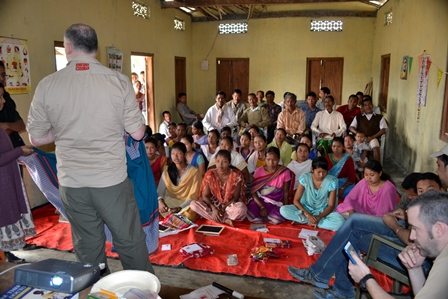
“To be honest we learnt as much as the participants did. We were intrigued to see what they were making; from simple cotton scarves to intricate wraps-table linen-pickles and chutneys to ornamental raffia models.
“We were also keen to understand what the villagers saw as preventing them from selling more products and asked how we could help. The sessions dealt with basic marketing skills such as labelling-packaging-‘standing out’ and pricing.
“Lorraine and Mike are both qualified first aiders at Chester Zoo and we offered their experience to help give some basic first aid lessons to locals. Arms slings-to the recovery position and how to prevent someone choking were practised across all four of the sites we visited.
“We had tons of questions and great interaction with the villagers-some of which had travelled miles to come and see us. We were overwhelmed by the interest in what we were able to teach and wished we could have spent more time with them and met more people.
“We took the opportunity on two days to visit local weekly markets. Over one thousand locals massed at these sites with rows and rows of stalls of product.
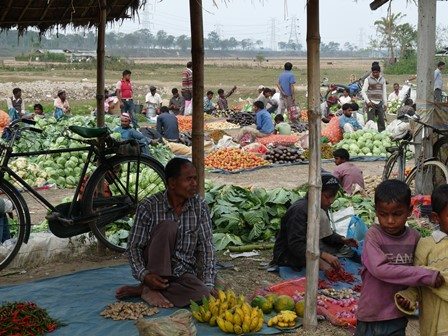

Fantastic looking fruit and vegetables sat alongside textiles-cooking pots-wooden bed frames and carrier bags. We spent a few hours meeting and talking with locals-using our interpreters and exploring the colourful and busy streets of product.
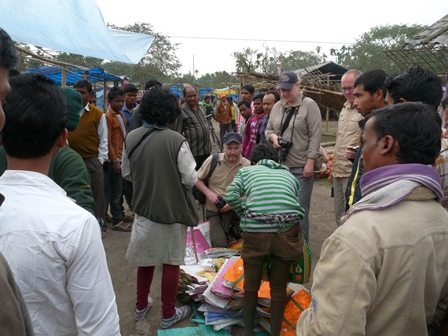 The team meeting and talking to the locals at the markets
The team meeting and talking to the locals at the markets
We also learnt that these markets acted as great networking opportunities and the Assamese enjoyed getting together to meet friends and relatives as well as doing business.
“During the workshops we were invited in to the heart of the villages-watching the handlooms in action in every household-enjoying rice wine with the whole village and always being offered refreshing cups of sweet tea as well as smiles and laughter from everyone we met.
“Sitting alongside the electric fences-whole communities go about their daily lives and it must have been so odd for them as we marched in with cameras and ipads-heavy rucksacks full of equipment and lots of noise!
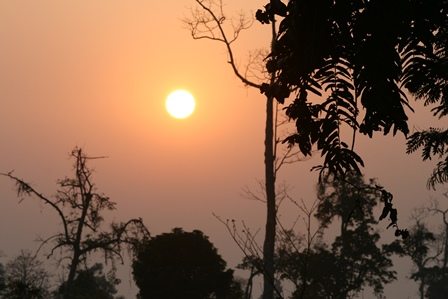
“My favourite memories include sitting on the concrete floor outside a school room watching the sun set one evening and enjoying the music and dancing prepared by locals at a rice wine session! I will also remember the friends we made-the close bond our group formed over the two weeks we were together.
“Assam seems a million moons ago now and I often still think about what is going on in the villages today. I hope the work we did helped and I can’t wait to go back again and experience India all over again.”
Vicki Small-Chester Zoo keeper-was tasked with preparing and delivering a number of workshops for the villagers providing more advice and techniques on caring for their livestock.
Vicki tells us more:
“Where to begin…
“After leaving Chester Zoo on the Saturday we took a mini bus-three planes and a car to get to the first hotel. All went without a hitch-though I did get searched twice at the airport – I must look dodgy! Wearing the Chester Zoo Expedition shirts created quite a stir with many people-which was a great ice breaker for us to then explain what were up to-oh and sell a few memberships at the same time for the zoo!
“So what exactly were we up to?
“For me I was in charge of preparing and delivering the Animal Husbandry workshops -which soon got re-named to Animal Health Workshops as this was the primary focus. As part of the preparation I sent a questionnaire to Ecosystems India (our partners in India for this programme) with various animal livestock related questions-in order to gain an insight to which areas of animal husbandry they felt the villagers needed the most assistance with. The questionnaire found that the biggest issue was the health of the animals-since veterinary support is hard to come by in such rural locations.


“After extensive research and piecing information together I came up with the following program-which split into three elements:
“Theory
Theory covering symptoms-causes-treatment and prevention of common diseases and health issues such as worms-ticks-mastitis-egg bound poultry-mites and liver fluke. Also a section on setting up barrier techniques and isolation areas to contain diseased animals therefore preventing the spread of diseases to other livestock and people.
“Practical
Three practical elements:
A drenching gun demonstration on a goat (a means of getting solution into livestock for worming or general hydration purposes-drenching guns were left with Ecosystems India for the villagers to use once we left).
Hydrating poultry using a syringe.
Making a home-made insecticide which was then applied to a local chicken.
“Consultation
One-to-one consultation with the villagers and their animals offering advice on all areas of animal husbandry.
“For treating common diseases it was essential not to suggest getting certain products from a vet which-would not only very expensive but not readily available. Instead using local trees and plants as insecticides-wormers and healing agents were suggested. Other resources suggested were: the use of wood ash as a natural anti-septic-mineral supplement and a means of stemming the blood flow on an injured animal-plus the application of a salt-sugar and water mix as a hydration solution.

“Even after all this preparation I shared similar concerns to Maile: ‘had I prepared the right stuff?’ and ‘would these be practices they already use?’ I had looked at pictures of Assam on the internet and farming in Assam-but I still wasn’t entirely sure what to expect.
“Right-back to being in Assam…
“My first taste of livestock was on this first journey – cattle and goats roaming around the city-in the middle of busy roads even crossing the road which does not stop traffic in Assam like it would back home. The drivers just drive around them-as to them this is the norm.
“On the morning of the first workshop I awoke to ‘bed tea’ (a guide brings tea to your lodge) and the sounds of hornbills and parakeets – not a bad way to start the day. As we arrived at the first village I was very excited and eager to share with the villagers the workshops I prepared.

“Parag my translator in Sonitpur-who is also a vet for the Pygmy Hog Breeding Centre in Assam-went through the printed off slides for the theory and to my delight knew the trees and plants I suggested and better than that could even point them out around the village from where we were stood-phew!
“The first workshop was an all-female audience of approximately 30-40 woman-one lady stood out with a very keen interest-excellent knowledge and strong leadership skills-this lady also volunteered to drench the goat.

“The workshop went really well-Parag and I connected instantly making working with a translator easier than I expected-plus we had banter throughout. I am use to teaching here in the UK but I relished this style of teaching; outdoors-sun on your back-nature around you and moving away from the traditional PowerPoint presentation. It was refreshing-but more rewarding was how the workshop was received.

The ladies took notes-asked questions and followed the content well. They recognised the animal diseases we spoke about plus the symptoms they caused but did not know how to treat them nor prevent them. The women were amazed when Parag pointed out the trees they could use as they had no idea these trees had such medicinal properties.

“I left this village on a huge high yet also exhausted! Three to four hours of non-stop teaching is draining-especially in that heat! The workshops continued like this throughout the villages we visited. A few concepts were not always seen as a plausible practice for the villagers to implement-especially land management ideas as the land used is common land therefore lacked ownership.
“The last village we visited in Goalpara weren’t so receiving-to begin with.
“This particular village had only been a part of the Assam Haathi Project for six months. I gained an insight to the many trials and tribulations the project team have had when starting out with a new village. It takes time for the villagers to trust an outsider-to listen to them-let alone change traditions and a way of life just because one person says it will make things better. It is a huge gamble in the eyes of the villagers-if these new methods don’t work it is a huge loss of time-energy-money and resources that are extremely precious to these communities.

“Quite quickly into this workshop I could sense the villagers were not openly receiving the information but rather appeared guarded-weary and even at one point mocking of the suggestions as felt they were totally unrealistic. At one point my translator even refused to translate to me.
“A corner was turned once treatments were suggested that were received in a positive and welcoming manner-the ice had been broken and the walls shaken to allow the message to be delivered with what was in the end open arms.
“Later these particular villagers approximately 40 men were the most thankful-gratuitous-gracious and overwhelming welcoming people so far (if that is at all possible-since all the people I met out there were beyond the kindest-most gentle and warm people ever to have been met). A leaf truly had been turned-a battle won but not yet the war.
“It wasn’t all work out there we did have some down time allowing us to see and appreciate the beauty and extraordinary wildlife Assam has to offer.
Here are my highlights: river dolphins within 10 foot of the raft we were in; one horned rhinos so close I could hear them chewing; water-Buffalo with the hugest horns I have ever seen; tiger footprints so fresh you know it has not long ago walked right where you are; and Chital breaching the surface of the water sending out rays of silver. A-ma-zing!

“Assamese people are kind and live life to the full-the women are very hard working and hold the families together. The project team in India go above and beyond to help their local people and protect the precious wildlife especially the Asian elephants. Many an evening in front of the campfire sharing stories-life events-playing games meant I gained new friends amongst my colleagues at Chester Zoo.
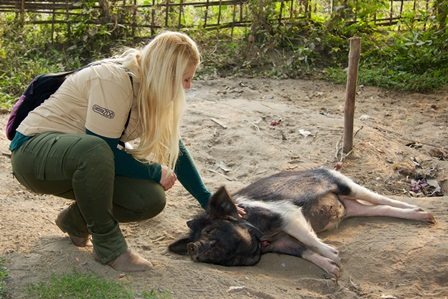
“At first I found Assam very alien and overwhelming in terms of heat-smell-landscape and culture yet totally captivating and after just two weeks felt very at home and was reluctant to leave. The Assam Haathi Project is a very worthwhile conservation project and I am honoured to have been a part of this expedition.”
You’ve been following the updates from the Chester Zoo team-but here is a short video showing you just what the Assam Haathi Project is doing and how we’re helping to keep elephants and people from harm.
Through a series of workshops different members of the group were able to offer support to long-term strategies for elephant conservation – looking at the techniques that have already been developed to reduce conflict and methods of alternative livelihoods.
Providing the communities with an alternative livelihood reduces the village’s dependence on crops that are raided frequently by elephants.
Our lead horticulturist at Chester Zoo – Maile Belanger – worked with the villagers to look at how they can increase the productivity of crops that are grown.
These workshops had a great turn out. Overall Maile was able to provide advice to over 230 people from 6 different villages in Assam.
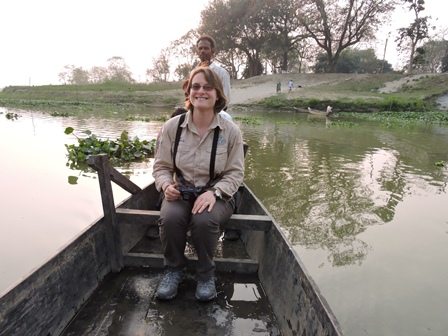
Here she tells us more:
“I have travelled to South East Asia before so I thought I knew what I was letting myself into as to climate and living conditions. My only worry was about how my workshops would go down in the villages – had I prepared the right stuff and would they listen to a foreigner giving them advice.
“I was really excited about going to India because I have never been before and the expedition was giving us a chance to see ‘real’ India and not the areas that tourists would be seeing.
“I was really surprised how dusty and smoggy Guwahati was. I knew it was the dry season and the temperatures would be very comfortable but I just did not expect the amount of dust or how brown everywhere looked! Not the image of tropical India that you have in mind.
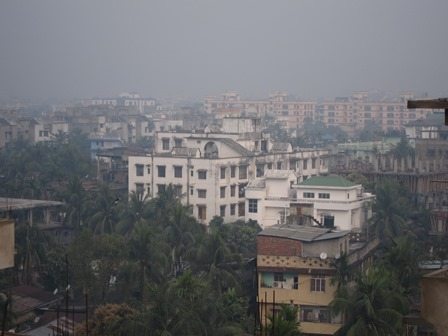
“Traffic was another surprising experience with all the different types of vehicles trying to use the road – trucks-buses-cars-rickshaws-tuk tuks-push carts-cows-bikes – and all using their horns at once! Road markings and signs meant nothing – you could have four lanes in two and traffic going the wrong way. But everyone was calm there was no road rage-people just went with the flow.
“So-my main role for the expedition was being a horticulture expert and keen vegetable grower. I was tasked with preparing a workshop that would run for a few hours.”
“I wanted to know what vegetables were grown-the problems with pests or diseases-if soil testing was done-was compost made from kitchen waste-and whether companion planting and crop rotation techniques were used. Based on the feedback from the villages and what the need was-I prepared 2 separate presentations.
“I’m glad I went prepared with print outs because most times the workshops were held outside with no power around!”
“I really enjoyed preparing the workshops as I learnt a great deal myself. As I’m used to working in a different climate-with different soils and plants etc it meant I had to do a lot of research around the plants and pesticide ingredients that would be available in India.
“For example baking soda can be used as a fungicide and when I asked about the availability of baking soda I got this reply from Nandita (Assam Haathi Project co-ordinator:
‘Baking soda is readily available. In fact before baking soda was introduced in the rural areas-distilled water & ash made from burnt banana trunk was-and still is-traditionally used for cooking certain dishes. This water is called khar in Assamese.’
“One of the aims of the Assam Haathi Project is to reduce the reliance the villagers have on the income from their rice or tea fields. The project encourages the villagers to grow more vegetables for themselves so that if they do lose income because of elephant damage then they still have a means of feeding themselves.
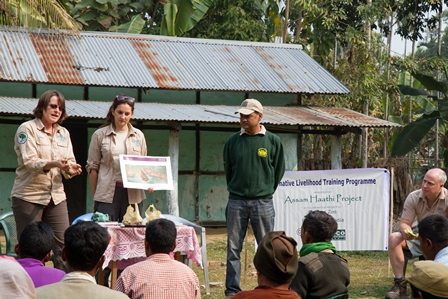
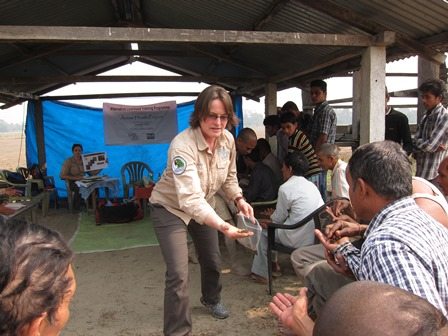
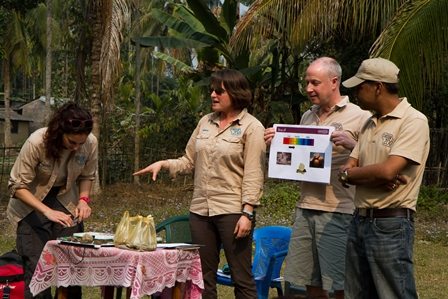

“So-the main purpose of my workshop was to try and improve home vegetable production. So-I focused them on two topics:
Soil – soil texture-pH-soil nutrients-compost making-green manure
Pest and Diseases – pests-homemade pesticides-diseases-avoiding diseases-homemade fungicides-companion planting-crop rotation
“The workshop was very important not just because of the knowledge I shared but also because of the link we are maintaining between the zoo-Eco-Systems India and the villagers.
“I think to some villagers I was also able to introduce new techniques to help improve their production. For example-home composting seemed to be a new idea to them and they seemed excited that they could recycle their kitchen scraps and then use the compost to improve their soil.
“The villagers were all very attentive during the workshops and were not afraid to ask questions – several took notes during the workshop. Each village was very welcoming. I had asked the villagers to bring a soil sample from their garden and any examples of pests and diseases with them. Sometimes they were shy about bringing these things forward but once I started talking about soil it was hard to then get through everyone’s questions and queries!
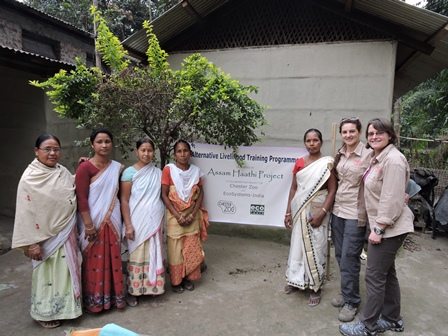
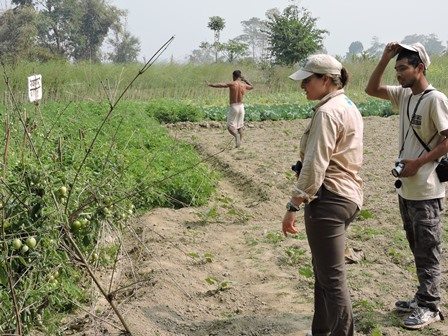
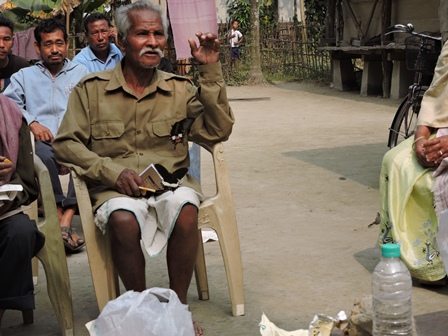

“As the workshop went on more problem plants were brought forward as well. Some topics were new to them like composting-companion planting and homemade pesticides/fungicides. It was such a relief for me to know that what I had prepared was useful.
“Without the project we wouldn’t have been able to do our workshops. It has created such a great working relationship with the villagers – they trust the project team and because of that trust the villages welcomed us in. Also through the Assam Haathi Project real solutions that work are being found and implemented in the villages (including wood efficient cook stoves-looms for weaving-education about elephants-chilli nurseries-electric fences-and bamboo and banana plantations). It is a two way project where we are learning from the villagers and listening to what they need/want and the villagers are learning from us.
“The highlight for me was the feeling that I could have given information to people that will make their lives better-and help to protect the elephants from harm. It was such a rewarding and humbling experience and makes me appreciate all that I have. It was such a great privilege to be invited into these small villages in rural India and learn from them. We were treated to several cultural dances and samplings of some homemade rice beer. I feel I have made many friends there and would love to go back to help in any way that I can.”
